'Mission: Impossible II' And The Final Bastion Of Hollywood Villains Being Coded As Gay
(Welcome to Queering the Scene, a series that explores LGBTQ themes and content in films of all kinds...especially where you least expect it.) Queer representation in cinema has often been problematic. As a result of queer coding, the LGBTQ+ community was often portrayed as violent, threatening, and abhorrent, an active threat to civilized heteronormative society. But queer coding isn't a new concept. In fact, its roots lay deep within film history.
Those roots will eventually take us to Mission: Impossible II of all things. But first, we need to look back. Far back.
A Quick History Lesson
Some of the earliest depictions of homosexuality on film can be traced back to two men dancing in William Kennedy Dickson's 1895's film The Dickson Experimental Sound Film, often referred to as The Gay Brothers. The short subverted expectations of typical male behavior, shocking moviegoers. At the end of the 19th century and into the 1920s and '30s, we started to see the coding that would become so damaging to queer representation in Hollywood, rooted primarily in gender-based stereotypes. Terms like sissy, pansy, limp-wristed, and light in the loafers or walking with mincing steps became commonplace when describing gay people, while lesbians were often associated with deep voices, masculine clothing, and typically masculine jobs. When the film industry picked up in the 20s and 30s, you started to see work produced with lewd and shocking subject matter like violence and prostitution that was often connected directly to queer representation. It was all in an effort to get people back to the theatre, but it caused a huge uproar from the general public. This all lead to boycotts, religious fervor, and, eventually, the Hays Code. The Motion Picture Production Code, also known as the Hays Code, was one of the first instances of censorship within the film industry in the US. It was founded based on the concept that "if motion pictures present stories that will affect lives for the better, they can become the most powerful force for the improvement of mankind," implying they also had the potential to cause great harm. Given the retaliation and vitriol that came from religious groups following portrayals of sexuality, violence, or queerness, they wanted to fight against the moral corruption of US citizens and their children. The three general principals of the code were as follows:
For the most part, these were just suggestions, and there were no legal ramifications for failing to adhere to the Code. However, if you didn't, your film would never see the light of day. As a result, the Hays Code directly influenced all of the content created in the early 20th-century film industry – well, until it was dismantled and replaced by a rating system in the 1960s. Unfortunately, the damage was done. The Hays Code meant that, while you couldn't have lewd subject matter in your film in any overt way, you could be clever and include it covertly. As a result, we started to see queer coding, the process whereby characters are given typically queer traits or behaviors as a means of suggesting they're not heterosexual or cisgendered without having to actually say so. In some instances, this was done as a means of covertly including queer characters. Predominantly? Coding was used as a means of portraying gay characters as superfluous or downright villainous. This kind of coding aligns queer characters with villainy, debauchery, and the downfall of civilized society. We saw this with Peter Lorre's character, Joel Cairo, in The Maltese Falcon, arguably one of the earliest examples of overt queer coding of a villain. In the book, Cairo is a gay man, without question. But if John Huston wanted his film to get made and see release, Cairo's gayness had to be played subtly, never actually calling a spade a spade. Alfred Hitchcock was no stranger to queer coding his villains, arguably using the technique in 10 of his films: Martin Landau's Leonard in North By Northwest, Robert Walker's Bruno in Strangers On A Train, John Dall's Brandon and Farley Granger's Philip in Rope (admitted by out screenwriter Arthur Laurents to be "obviously about homosexuals"), Anthony Perkins' Norman Bates in Psycho, and Judith Anderson's Mrs. Danvers in Rebecca, to name a few. Then there's Disney, the ruling class of queer coding. As kids, we were given Scar, Hades, Ratigan and a slew of other male villains who were largely coded as somehow not quite manly enough. Their lack of conventional masculine traits and vaguely effeminate mannerisms meant you could easily portray them as villains because they defied the status quo as we knew it and as we taught it to our children. Meanwhile, the female villains like Ursula (whose design was inspired by drag legend Devine), Maleficent, and Cruella Deville were presented as antithetically feminine so as to be positioned as corrupting influences on the young women of the day. This technique was used in the early days of the Hays Code and well before, when lesbians were portrayed as corrupting influences on impressionable young women. It left a lasting impression – even if it eventually backfired. Queer coding impacted pop culture so deeply that we started to accept the harmful stereotypes as factual representations. Queer/Gay/Lesbian/Bi/Trans – all of the above were bad. Frank N Furter in The Rocky Horror Picture Show is a greedy bisexual transvestite who just wants to take take take and corrupt anyone around him. Dr. Robert Elliott in Dressed To Kill is a murderous, psychotic transvestite. Buffalo Bill in Silence of the Lambs: another murderous, psychotic transvestite. Catherine Tramell in Basic Instinct: psychotic bisexual serial killer. Governor Ratcliffe in Pocahontas: a gay-coded xenophobic colonialist. Xerxes in 300 is the ultimate flamboyant, gay-coded villain. Are you seeing a pattern yet? The trend hasn't gone away. Now we often see coding as infinitely more subtle and arguably more insidious, being used as something to hide behind without actually having to do any work. We saw this with LeFou in the live-action adaptation of Beauty and the Beast as well as Lando Calrissian in Solo.
A Magnum Opus of Homophobic Queer Coding
19 years ago, in May of 2000, John Woo created a stunning magnum opus to queer coding that has seldom been topped: Mission: Impossible 2. Or as I've come to call it while working on this piece, Homophobia: The Movie. In this installment, Ethan Hunt (Tom Cruise) and his IMF team are after a deadly virus-turned-biological weapon called Chimera. The mission they've chosen to accept is to find it and destroy it before rogue IMF agent Sean Ambrose (Dougray Scott) gets his hands on it and unleashes it on the world. Presumed friend of Hunt, Dr. Nekhorvich (Rade Serbedzija), created the virus, giving only this explanation as to its purpose: "Every search for a hero must begin with something that every hero requires – a villain. Therefore, in search for our hero, Bellerophon, we created a monster – Chimera." It's in these opening shots that we see the first hints of coding: a dark, sterile lab where death is born...with a rainbow? There's no logical reason for this to happen. A little grade 1 science here, but rainbows form when light is refracted, reflected, and dispersed through, typically, water. You don't get rainbows through straight sheets of glass such as windows. This placement is specific and deliberate. 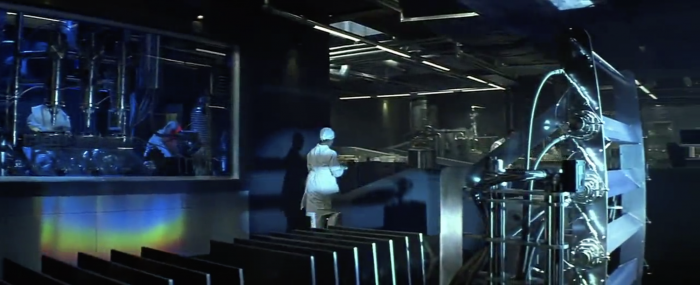 But it could be a fluke...right?When Nekhorvich leaves his lab, infected with the virus, he walks outside to a group of children dancing and singing "Ring A Ring 'O Roses", ashes ashes and all. For those who may not know, the nursery rhyme has a long history of being connected to the Bubonic Plague, though this is mostly just an urban legend. However, it's a concept deeply ingrained in the public consciousness, often simply with the association of death. The fact that these kids are all in grey formalwear is both ominous and confusing. But the fact that there are couples walking all around them, and every pairing is same-sex? Well, now, isn't this telling.
But it could be a fluke...right?When Nekhorvich leaves his lab, infected with the virus, he walks outside to a group of children dancing and singing "Ring A Ring 'O Roses", ashes ashes and all. For those who may not know, the nursery rhyme has a long history of being connected to the Bubonic Plague, though this is mostly just an urban legend. However, it's a concept deeply ingrained in the public consciousness, often simply with the association of death. The fact that these kids are all in grey formalwear is both ominous and confusing. But the fact that there are couples walking all around them, and every pairing is same-sex? Well, now, isn't this telling. 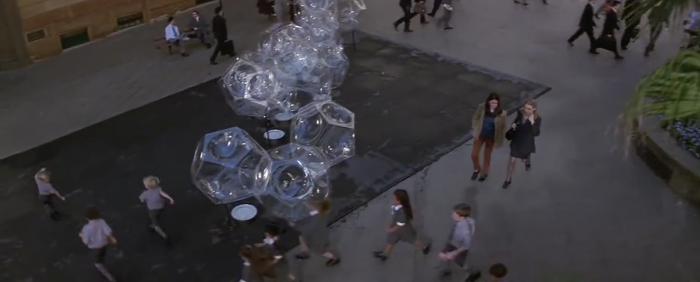 We then meet Nyah (Thandie Newton), Hunt's love interest for the next hour and a half – a unique step in and of itself when you consider a fast love affair on the job is distinctly out of character for Hunt, and he never does it again in the entire franchise. But Nyah is special, because she's the "beard" ex of our villain, Ambrose, and he wants her back at all costs. Ambrose's right hand man, Hugh Stamp (Richard Roxburgh), isn't pleased with Nyah's return. They try to play it off as base-level suspicion, but Hugh is coded as the gay jealous lover from top to bottom. The framing, thanks to Top Gun director of photography Jeffrey Kimball, positions Hugh unequivocally as the jealous lover watching from afar.
We then meet Nyah (Thandie Newton), Hunt's love interest for the next hour and a half – a unique step in and of itself when you consider a fast love affair on the job is distinctly out of character for Hunt, and he never does it again in the entire franchise. But Nyah is special, because she's the "beard" ex of our villain, Ambrose, and he wants her back at all costs. Ambrose's right hand man, Hugh Stamp (Richard Roxburgh), isn't pleased with Nyah's return. They try to play it off as base-level suspicion, but Hugh is coded as the gay jealous lover from top to bottom. The framing, thanks to Top Gun director of photography Jeffrey Kimball, positions Hugh unequivocally as the jealous lover watching from afar.  Hugh and Ambrose even have a quarrel the morning after her arrival that ends with some very suggestive framing. Ambrose holds Hugh down, standing behind him, in order to snip the tip of his finger off in a disciplinarian move that vividly suggests pleasurable sodomy.
Hugh and Ambrose even have a quarrel the morning after her arrival that ends with some very suggestive framing. Ambrose holds Hugh down, standing behind him, in order to snip the tip of his finger off in a disciplinarian move that vividly suggests pleasurable sodomy. 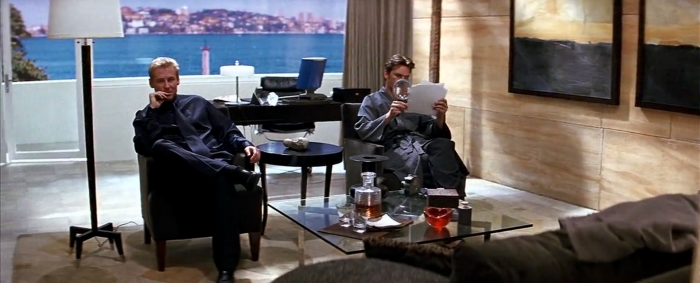
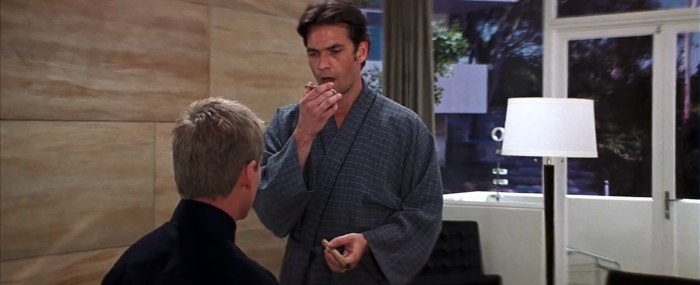
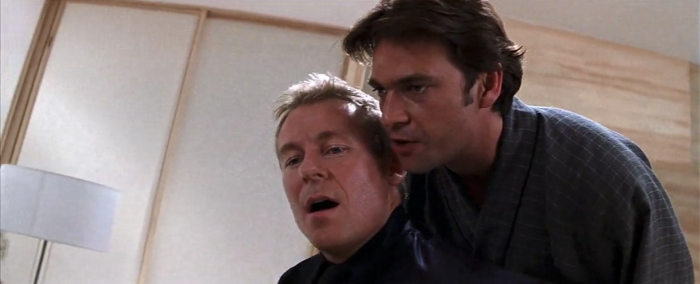
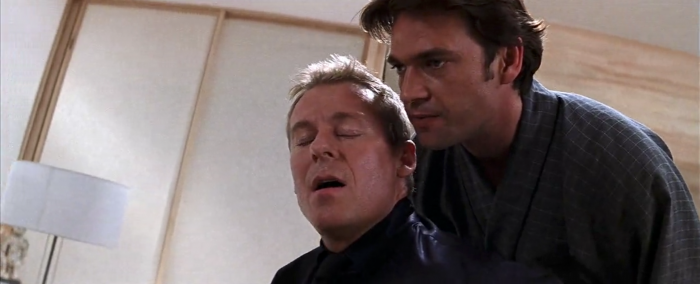
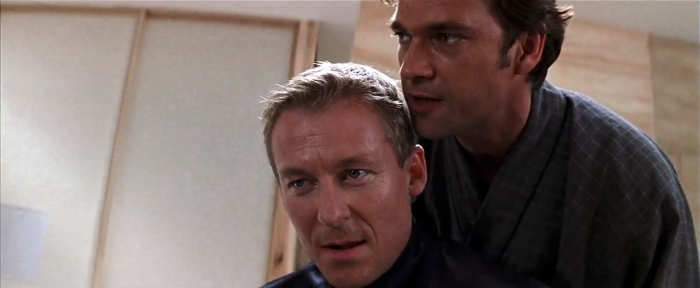
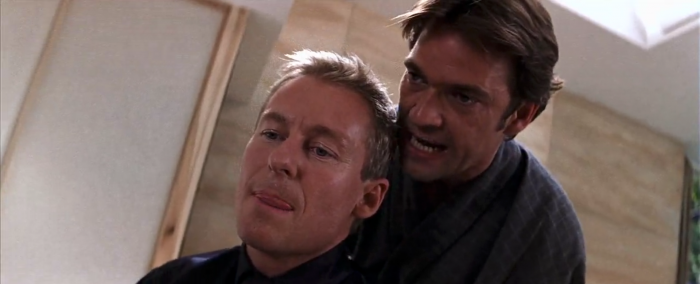
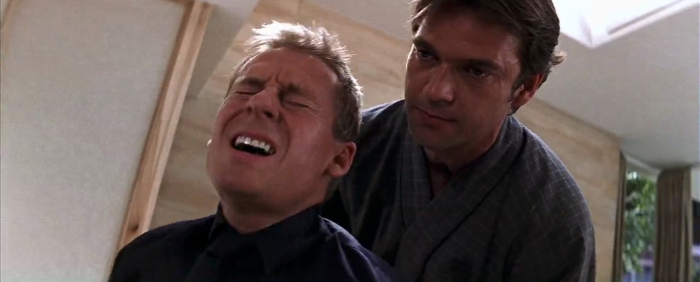
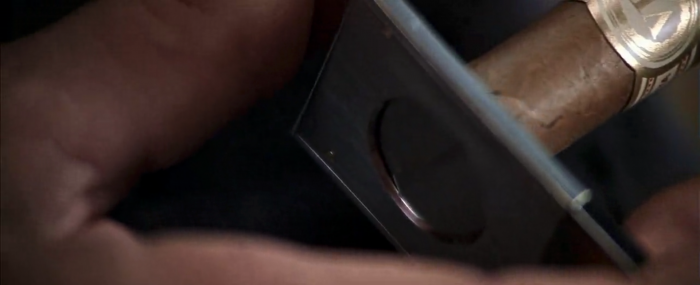 What was that? Oh, sorry. I thought I heard a volleyball match going on in the background. Perhaps you're familiar with the harmful notion of "the homosexual agenda", a term coined by the Christian right in the 1980s to condemn the normalization and social acceptance of LGBTQ+ people and lifestyles. It purports that gay folks infiltrate regular society by passing as straight in order to seem less threatening and, therefore, worthy of acceptance. It's antiquated and pure homophobic fear mongering. But in 2000, it was something plenty of folks bought into. Hell, it still is. And what M:I 2 was doing at the time was coding Chimera, our destructive chemical weapon, as the homosexual or gay agenda. So in the process of coding the villains, Ambrose and Hugh, as gay, the heroes, Nyah and Hunt, as straight, and Chimera as the gay agenda, Woo successfully coded homosexuality in its entirety as a violent threat to mankind.From the very beginning, M:I 2 not only posits that queerness in general is an aberration, but that it's synthesized. We watch as Chimera is created in a lab, a manufactured foil to the heterosexual Bellerophon. The very name itself, Chimera, stems from the creature from Greek mythology comprised of a lion's head with the body of a goat and a snake for a tail. It's an abomination. Bellerophon, on the other hand, was often regarded as one of the greatest heroes of all time and portrayed as the perfect specimen of a man who slays the Chimera. On top of the mythological elements, M:I 2 reinforces the grossly false ideology that has put queer lives in danger for decades while damaging the public perception of queerness: that queerness is itself an abomination, and an active choice implying its fabrication. The film presents imagery that suggests that the fight for normalizing gay culture, the fight for queer equality and rights for the LGBTQ+ community is tantamount to fighting for the world's destruction. In the process of coding its queer villains and heteronormative heroes – the personifications of both Chimera and Bellerophon, respectively – Woo managed to code the entire LGBTQ+ community and queerness itself as not only villainous but threatening to the heterosexual norm, procreation, and the sanctity of life itself.
What was that? Oh, sorry. I thought I heard a volleyball match going on in the background. Perhaps you're familiar with the harmful notion of "the homosexual agenda", a term coined by the Christian right in the 1980s to condemn the normalization and social acceptance of LGBTQ+ people and lifestyles. It purports that gay folks infiltrate regular society by passing as straight in order to seem less threatening and, therefore, worthy of acceptance. It's antiquated and pure homophobic fear mongering. But in 2000, it was something plenty of folks bought into. Hell, it still is. And what M:I 2 was doing at the time was coding Chimera, our destructive chemical weapon, as the homosexual or gay agenda. So in the process of coding the villains, Ambrose and Hugh, as gay, the heroes, Nyah and Hunt, as straight, and Chimera as the gay agenda, Woo successfully coded homosexuality in its entirety as a violent threat to mankind.From the very beginning, M:I 2 not only posits that queerness in general is an aberration, but that it's synthesized. We watch as Chimera is created in a lab, a manufactured foil to the heterosexual Bellerophon. The very name itself, Chimera, stems from the creature from Greek mythology comprised of a lion's head with the body of a goat and a snake for a tail. It's an abomination. Bellerophon, on the other hand, was often regarded as one of the greatest heroes of all time and portrayed as the perfect specimen of a man who slays the Chimera. On top of the mythological elements, M:I 2 reinforces the grossly false ideology that has put queer lives in danger for decades while damaging the public perception of queerness: that queerness is itself an abomination, and an active choice implying its fabrication. The film presents imagery that suggests that the fight for normalizing gay culture, the fight for queer equality and rights for the LGBTQ+ community is tantamount to fighting for the world's destruction. In the process of coding its queer villains and heteronormative heroes – the personifications of both Chimera and Bellerophon, respectively – Woo managed to code the entire LGBTQ+ community and queerness itself as not only villainous but threatening to the heterosexual norm, procreation, and the sanctity of life itself. 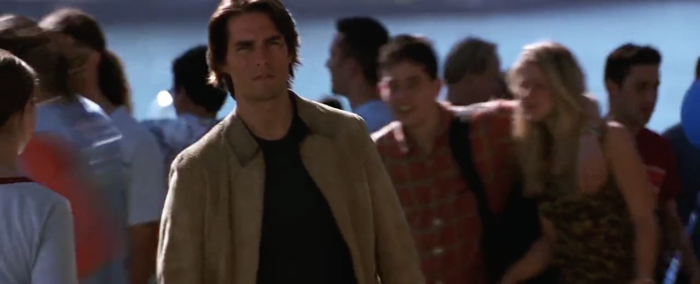
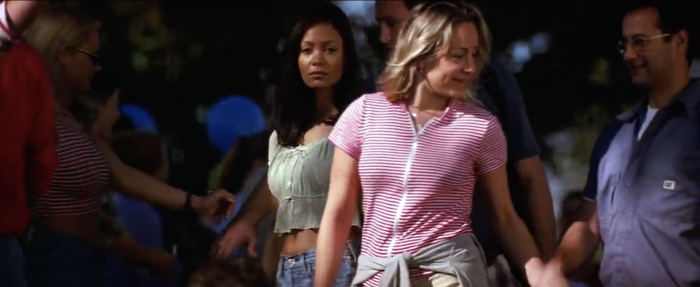
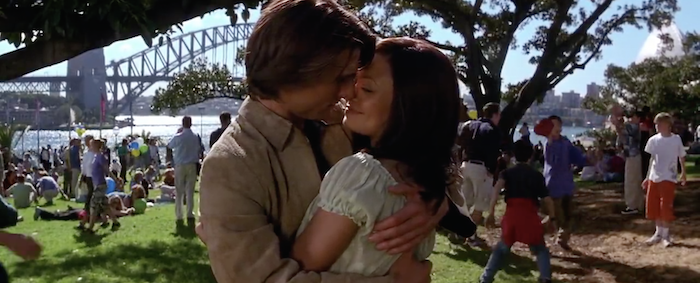
 Remember that heavily-coded opening scene? With children singing a nursery rhyme linked to the plague that decimated between 25-60% of the entire European population while same-sex "pairings" (READ: couples) walked around them? The end of the film steers as hard as possible in the other direction. Hunt and Nyah see one another across a sunlit field full – and I mean FULL – of children happily playing in the sun surrounded straight couples and families. They meet. They kiss. And they walk off into a living recreation of Seurat's A Sunday Afternoon On The Island Of La Grande Jatte, here positioned as the heteronormative future. Life returned to the status quo, where marriage is between a man and a woman, and children can run free unafraid of that dreaded gay agenda out to corrupt them.
Remember that heavily-coded opening scene? With children singing a nursery rhyme linked to the plague that decimated between 25-60% of the entire European population while same-sex "pairings" (READ: couples) walked around them? The end of the film steers as hard as possible in the other direction. Hunt and Nyah see one another across a sunlit field full – and I mean FULL – of children happily playing in the sun surrounded straight couples and families. They meet. They kiss. And they walk off into a living recreation of Seurat's A Sunday Afternoon On The Island Of La Grande Jatte, here positioned as the heteronormative future. Life returned to the status quo, where marriage is between a man and a woman, and children can run free unafraid of that dreaded gay agenda out to corrupt them.
